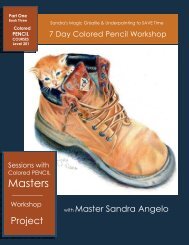Create successful ePaper yourself
Turn your PDF publications into a flip-book with our unique Google optimized e-Paper software.
6.5lt petrol and it was mounted behind the driver’s cab and underthe cargo load deck. The engine was rated at 220hp at 3750rpmto produce road speeds of around 40mph. The transmission anddifferentials were located in front of the engine and the vehiclewas fitted with five forward and five reverse gears. Whenentering water in its amphibious role the Stalwart could reachspeeds of up to 6mph by means of two water-jet thrusters. Itwas steered by using the steering wheel. A later version of theStalwart, the Mk 2 General Service (known as the FV622), wasfitted with more powerful thrusters to produce speeds of up to10mph when engaged in amphibious operations.The Stalwart had a kerb weight of 9 tons and could carrycargo loads of up to 5 tons. Although it had a wheel basemeasuring 10, feet the vehicle had an overall length of 20 feet10 inches. It measured 8’ 7” in width and 10’ 3” to the top ofthe cab and had a fuel capacity of around 100 gallons. TheStalwart had an operational range in excess of 500 miles. Thebows of the cab were well-angled to enter the water and exitfrom rivers by climbing the banks using its ability to scalesharp inclines.The large rear cargo-carrying deck area was fitted withdrop sides, which were fitted with seals to prevent the vehiclefrom flooding. Although designed specifically as a cargo carrierto transport fuel, ammunition and other supplies, the Stalwartcould transport up to 30 fully-equipped troops in an emergency.The Mk 2 FV622 was fitted with improved windows in thecab and could carry up to 38 troops. The FV623 “Limber” wasfitted with an Atlas hydraulic crane (rated to lift loads of 3 tons)behind the driver’s cab to help ease the handling of loads duringloading and unloading. The Stalwart could also tow loads of upto 10 tons, such as pieces of artilleryand trailers with ammunition.Apart from the basic Mk 1FV621 and the other versions of theFV622 and FV623, there was anotherspecialised version developed forthe Royal Electrical & MechanicalEngineers. This is a Corps unit of theBritish army and was formed in 1942.Today, the seven battalions maintainthe complex weapon systems of thearmy and the whole range of otherelectronic equipment to keep the armyoperational.The version of the Stalwartdeveloped for the REME was theFV624. It was fitted with twoadditional seats for crew and a heavierlift crane to cope with engines on the armored vehicles.The vehicle was only ever used by the British army anddeployed to those areas where its services were required,including the former West Germany as part of the British Armyof the Rhine (BAOR) to transport equipment and supplies acrossthe many rivers there.The large flat cargo area of the Stalwart made an idealplatform as a work area or to permit systems to be mounted, suchas battlefield radar and weapon systems, like the British army“Ranger” anti-personnel mine-dispensing system. The StalwartThe large driver’s cab could easily accommodate threepeople and the windscreen gave good visibility althoughthe ‘blind spot’ close to the vehicle was a problem thedriver could be guided by a man giving directions.The Stalwart had good amphibious qualities and this trio of vehiclesbetween them could transport either 15 tons of supplies or almost100 men with all their equipment. A “freeboard” device was loweredin front of the vehicle when engaged in amphibious operations toprevent the ‘wash’ from splashing up the obscure the driver’s vision.The freeboard device did obscure the driver’s vision when exitingthe water when climbing river banks and so the co-driver wouldcall down directions from his position on the roof. Very basic but itworked well. Ministry of Defensewas never armed, but when engaged in deploying mines, itprovided support in its engineering role and supplemented themore specialised vehicles engaged in laying mines .Because of its role and operational duties took thevehicle off-road and into some extreme terrain, the Stalwartbecame a high maintenance vehicle. Indeed, the vehiclewas not without its faults and heavy use led to a numberof automotive parts wearing outvery quickly. The Stalwart wasgradually phased out of serviceduring the late 1970s onwards.Its role has been taken over byhelicopters and the like.Around 1,600 Stalwarts of allvariants were built. Today, many arein private ownership. The owners areaware of the mechanical servicingrequired and for that reason theytend to move the vehicles longdistances on low-loaders.Like the other two 6x6 vehiclesin the range developed by Alvis, theSaladin and the Saracen, the Stalwarthas also been used in films andtelevision programs such as Tankboyand Firefly. Film credits include Tomb Raider: The Cradleof Life and Children of Men. Stalwarts do come up for sale. Oneowner who recently put his FV624 REME version Stalwart upfor sale was seeking £6,500GBP (or a little over $10,500). Thishad less than 1,000km (about 621 miles) on the clock. The ownerhad used it during the 2007 floods in Tewkesbury in Gloucestershire,UK, to rescue flood victims.Occasionally Stalwarts are used to give vehicle rides togroups and, apart from showing their mobility at vehicle events,can be seen as exhibits in military museums. ✪Military Vehicles Magazine June 2013 15







![Index [media2.fwpublications.com] - F+W Media](https://img.yumpu.com/45216355/1/190x245/index-media2fwpublicationscom-f-w-media.jpg?quality=85)








